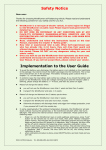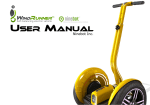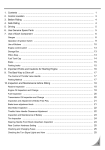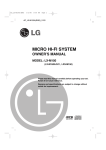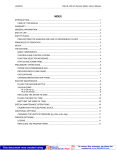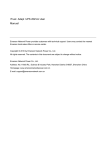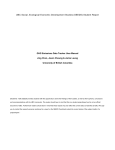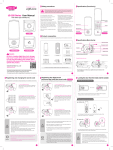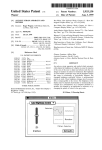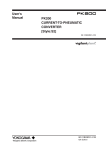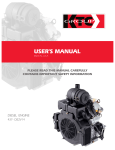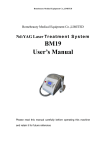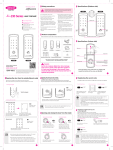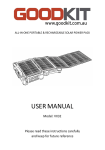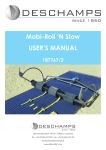Download USER MANUAL - Carts & Wheels
Transcript
USER MANUAL Caution of risks WindRunner™ self-balancing electric vehicle user’s manual Just the same as any other means of transportation, when you ride the WindRunner ™, you may lose control, fall, and become seriously injured in a crash. Therefore, please carefully read this manual and got experienced. With safe riding skills, you may reduce or avoid any hazards and risks. The figure on the left shows some unsafe riding situations. For example, the wet and Slippery surface of the road may cause your WindRunner to skid around and fall; Carefully read this manual to avoid any hazards and risks. For a further understanding of potential hazards and safe riding skills, login to our This manual will explain all of the operating instructions and precautions associated with official website ™: http://www.windrunner.cn/en for a “ safe riding instruction video”. using the WindRunner ™ to you. You must carefully read, and obey this manual. Beijing UPTECH Robotics Technology Co., Ltd shall never be liable for any consequences incurred on account of improper and wrong operations. 2 Please buy or rent the WindRunner ™ from distributors authorized by UPTECH Robotics. If not, you may suffer the loss of our warranty and after-sale service. You may consult the local dealer listed on our official website. WindRunner™ self-balancing electric vehicle user’s manual Trademark registration and legal notices The WindRunner ™ is a trademark of Beijing UPTECH Robotics Technology Co., Ltd (hereafter briefly called UPTECH or UPTECH Robotics). ARM® is the trademark of ARM Company. Any other trademarks mentioned in this manual and all concerning rights shall be the proprietary of their owners. UPTECH reserves all rights for WindRunner ™, and “8-shape logo”. This manual was compiled by UPTECH. UPTECH owns all copyrights of this manual and without the prior formal permission from UPTECH, any organizations and persons are forbidden to duplicate or distribute all or part of this manual to others. 3 WindRunner™ self-balancing electric vehicle user’s manual About this manual Thank you for your choosing our WindRunner ™ electric self-balancing vehicle. This manual will help you: follow all the safe riding instructions, and obey the riding skills listed in this manual, and you can enjoy a safe and pleasant ride. to ensure a better riding experience. to perform the basic operations of WindRunner ™ before riding. to master routine maintenance, and also, contact of after-sale services. to Understand all aspects of performance, maintenance skills, and troubleshooting, to solve any problems as soon as possible. This manual derives accordingly, and is applicable for: WindRunner ™G1 series including G1U, G1X. 4 WindRunner™ self-balancing electric vehicle user’s manual Please pay close attention to the following marks and meanings. meanings Carefully read, and understand them well. improper use and/or operation can cause serious loss of property or heavy injury/death improper operation may cause malfunction or heavy damage to your WindRunner Helps you to rider better and easier 5 WindRunner™ self-balancing electric vehicle user’s manual Contents Caution of risks ................................................................................................................................. 1 Trademark registration and legal notices ................................................................................................. 3 About this manual ................................................................................................................................ 4 1. Introduction of WindRunner™ ...........................................................................................................11 1.1 How do a WindRunner work? .......................................................................................................11 1.2 Model of WindRunner G1 series ...................................................................................................12 1.3 Illustration of G1U/G1X ..............................................................................................................13 2. Install a new WindRunner .................................................................................................................14 2.1 Check the package content .........................................................................................................14 2.2 Check the S/N ...........................................................................................................................16 2.3 Assembly ..................................................................................................................................17 2.3.1 Tools required and preparations ............................................................................................18 2.3.2 Assemble the operating bar ..................................................................................................18 2.4 Intelligent remote keys ...............................................................................................................20 2.4.1 Function list ........................................................................................................................21 2.5 Test riding ................................................................................................................................22 3. Operating modes .............................................................................................................................25 6 3.1Standby mode ............................................................................................................................25 WindRunner™ self-balancing electric vehicle user’s manual 3.2 Power assistant mode.................................................................................................................26 3.3 Balance mode............................................................................................................................27 3.2.1 Beginner mode- 5km/h max .................................................................................................28 3.2.2 Speed limit mode- 10km/h max ............................................................................................28 3.2.3 Normal mode- 20km/h max ..................................................................................................29 3.4 Lock mode ................................................................................................................................30 4. Use the intelligent remote keys .........................................................................................................31 4.1 ON/OFF ....................................................................................................................................31 4.2 mode switch..............................................................................................................................31 4.3 Lock mode ................................................................................................................................34 4.4 Battery indication.......................................................................................................................35 4.5 Replace the battery of the key .....................................................................................................37 5. How to ride .....................................................................................................................................38 5.1 Before ride ................................................................................................................................38 5.2 Starting the WindRunner ............................................................................................................40 5.3 Verify the startup of beginner mode .............................................................................................40 5.4 Prior to get on ...........................................................................................................................41 5.5 Get on ......................................................................................................................................43 5.6 Move forward and backward ........................................................................................................44 5.7 Decelerate and stop ...................................................................................................................46 5.8 Make a turn ..............................................................................................................................48 7 WindRunner™ self-balancing electric vehicle user’s manual 5.9 Get off ......................................................................................................................................49 5.10 Use the power assistant mode ...................................................................................................50 5.11 Use the lock mode....................................................................................................................52 6. Safe riding instructions ....................................................................................................................54 6.1 You must strictly obey ................................................................................................................54 6.2 Strictly forbidden .......................................................................................................................55 6.3 Driving manners/safe riding ........................................................................................................58 6.4 Active protection instruction ........................................................................................................60 6.5 Intelligent safe alarm/protection ..................................................................................................62 7. Charging and battery maintenance ....................................................................................................66 7.1 Introduction of battery ...............................................................................................................66 7.2 Charging ...................................................................................................................................67 7.3 battery maintenance ..................................................................................................................69 7.3.1 Assembly / disassembly the battery pack ...............................................................................70 7.3.2 Improve the cycle life of the battery pack ...............................................................................70 7.4 Transport and recycle of the battery pack .....................................................................................73 8. Routine maintenance .......................................................................................................................73 8.1 Keep cleanness ..........................................................................................................................74 8.2 Check whether the screw is loose or not .......................................................................................75 8.2 Check the inflation pressure of tire ...............................................................................................75 8 8.3 Storage ....................................................................................................................................76 WindRunner™ self-balancing electric vehicle user’s manual 8.4 handling ...................................................................................................................................76 8.5 Repair ......................................................................................................................................77 9. Troubles and alarms ........................................................................................................................78 9.1 FAQs and troubleshooting ...........................................................................................................78 9.2 List of alarm information codes ....................................................................................................80 9.3 Spare parts for repairing and replacing .........................................................................................85 9.4 Reporting your troubles ..............................................................................................................85 10. Datasheet .....................................................................................................................................86 10.1 WindRunner G1U urban type .....................................................................................................86 10.2 WindRunner G1X all terrain type ................................................................................................87 Appendix A. More maintenance instructions ............................................................................................88 A.1 Replace the tire .........................................................................................................................88 A.2 Replace the fender .....................................................................................................................88 A.3 replace the foot mat...................................................................................................................89 A.4 replace the gear oil ....................................................................................................................90 Appendix B. Deep understanding WindRunner.........................................................................................93 B.1 Battery stamina and battery indication .........................................................................................93 Factors affecting the battery stamina .............................................................................................93 Accuracy of battery indication .......................................................................................................94 B.2 Tire and land form .....................................................................................................................95 B.3 About intelligent Speed limit .......................................................................................................96 9 WindRunner™ self-balancing electric vehicle user’s manual B.4 Hot back-up safety mechanism....................................................................................................97 B.5 G1X and G1U upgrading mode ....................................................................................................98 B.6 Brake lights ..............................................................................................................................99 Appendix C. Outline and dimensions .................................................................................................... 100 C.1 urban model G1U .................................................................................................................... 100 C.2 all terrain model G1X ............................................................................................................... 101 Contact us ........................................................................................................................................ 102 10 WindRunner™ self-balancing electric vehicle user’s manual 1. Introduction of WindRunner™ 1.1 How do a WindRunner work? The WindRunner™ is a dual-wheel self-balanceable electrically operated vehicle, a revolutionary ride-instead-of-walk and recreational tool. The driver may operate the movement of WindRunner by standing on it, and shifting his/her body. The WindRunner itself may automatically keep balance and the driver does not have to worry about the risk of falling. With the built-in electronic gyro, the on-board high speed CPU may calculate in 200 times/s whether the mainframe of WindRunner is balanced forward and backward or not. If not, the CPU may control the motor on both left and right sides to rotate rapidly, and keep the WindRunner balanced. The self-balancing function, allows the driver to stand on the WindRunner with his body inclined forward. The mainframe may automatically enable its wheels to move forward, and the WindRunner will move forward; and vice versa. Simply turn the handle left and right. Because the balance of WindRunner ™ completely depends on the good functioning of a high speed CPU, precision gyro, and motor, if any one of them has troubles, the WindRunner may lose balance. The WindRunner ™ has a hot back-up dual-redundant control system which ensures that all key circuit systems shall be doubled. Therefore, if any one of the key modules fails to work, the backup may be put into operation so as to maximize the safe riding. 11 WindRunner™ self-balancing electric vehicle user’s manual 1.2 Model of WindRunner G1 series Appearance Type Features G1U urban standard Easy removal of steering handle, and suitable for model storing into the luggage compartment of most of family-owned cars. G1UR urban G1U-based, higher capacity of battery stamina. for-rent model Equipped with external quick charger, and optional RFID billing system. G1X all terrain Low-pressure large-size all-terrain tire, shock standard model absorbance, and suitable for rugged and uneven path. With stamina slightly lower than that of G1U urban type. G1XR all terrain G1X-based, high capacity battery, and long for-rent model stamina. Equipped with external quick charger, and optional RFID billing system. 12 *the WindRunner may also be upgraded. See www.WindRunner.cn for details. WindRunner™ self-balancing electric vehicle user’s manual 1.3 Illustration of G1U/G1X 13 WindRunner™ self-balancing electric vehicle user’s manual 2. Install a new WindRunner 2.1 Check the package content Once unpacked, carefully take out the handle and put it aside. Then, take out the mainframe. The mainframe is relatively heavy; carefully take it out with the help of another person. Take care when picking up the wheel hub with your hands. Do not directly pick up the fender. Otherwise, the fender may be damaged,, and fingers may be squeezed and harmed. 14 WindRunner™ self-balancing electric vehicle user’s manual Immediately check whether all things in the package are just the same as shown in table below. If not, please do not hesitate to contact our sales representative. Chassis (including tire, operating bar quick release) 1 set Care to distinguish the all terrain type and urban type battery pack Lower and upper segment of operating bar, handle, 2 sets including one charging cable 1 set decorative cap Intelligent remote key 2 pcs Two general-purpose intelligent remote keys. One operating and one standby Battery of intelligent remote key 2 pcs Backup battery for intelligent remote key Dismantling tools and working gloves 1 set socket screw wrench, 1 set, working gloves, 1 pair instruction manual and safety riding instruction DVD, 1 set warranty card 15 WindRunner™ self-balancing electric vehicle user’s manual 2.2 Check the S/N All warranty terms are located on the warranty card and are guaranteed in three aspects: repair, spare parts, and contact method. All shall be signed by your seller upon the entry-into-effect date of warranty, contact method of the seller and stamp. Moreover, the last page of the warranty card should have been attached with the label of serial number. The serial number is the combination of 12-bit character and number. You may find the serial number located on the positions below: 16 Attached at the last page of warranty card. Attached at the place under the right foot mat. Outside of packing. meanings of serial number label and code WindRunner™ self-balancing electric vehicle user’s manual Each WindRunner has a unique serial number. number The serial number and warranty card are the only mark for enjoying the free maintenance and repair, and after-sale sale service. service Please verify the consistency of serial numbers at three positions mentioned above. If unconformities are found, it means that it may not be from an OEM.. If there is a problem, please don’t hesitate to contact our sales representatives. Please login the official website of WindRunner www.windrunner.cn, click the “repair and technical support” link located at the lower right part of screen, and click the “user registration” link in a new page. Register your warranty card as required; you may enjoy the free on-line on consultation and on-line after-sale service. 2.3 Assembly After you determined that all component parts are complete and intact, assemble a new WindRunner according to the following steps. 17 WindRunner™ self-balancing electric vehicle user’s manual Before handling, installing any component parts or making any cleaning and maintenance, remember to power off the WindRunner and cut off the charging cable. cable 2.3.1 Tools required and preparations Before assembling a new WindRunner, please take out a set of accompanied socket screw wrenches from the packaging. All these tools must be kept for future maintenance and transportation. You should wear the working gloves to protect your hands from dirt and scratches. 2.3.2 Assemble the operating bar 18 WindRunner™ self-balancing electric vehicle user’s manual Assemble the handle onto the upper segment of operating bar, and then fit the upper segment of operating bar with its lower segment together 2.fasten the quick release handle Insert the operating bar to the steering shaft Insert the operating bar into the steering shaft 1. Hold the nuts inside, revolve the quick release handle CW Hold-down the quick-release handle 19 WindRunner™ self-balancing electric vehicle user’s manual When assembling or removing the operating bar with quick-release handle, you should first remove the decorative cap of operating bar, then tighten the quick-release handle, turn it until the last turn is at its final place. Then hold-down the handle upward. upward If too tight, the handle shall be unable to hold down. Iff too loose, the handle han may be disengaged, fall off, and lead to a hazard. 2.4 Intelligent remote keys Each WindRunner has been equipped with two identical intelligent remote keys. key One is for operating, and the other is for standby and precautions against loss or damage. damage See figure below for the appearance of intelligent remote keys and functions of buttons. Batt. indicator Lock mode On/Off/ Unlock Operation mode 20 intelligent remote key contour and functions WindRunner™ self-balancing electric vehicle user’s manual 2.4.1 Function list ON/OFF/Unlock: For starting or turning-off the WindRunner. To start it you press it once. Once you start the WindRunner, if no driver is standing on it, press it once to turn-off (for safety reasons, if the WindRunner has been started and the driver is standing on it, it should be not powered off). Under the lock mode, press this button to unlock. Lock: if powered on, press this button to start the lock mode. Under lock mode, any movement or inclining in the mainframe may trigger an alarm; wheels locked up, cause vibrations and trigger the alarm. Battery capacity indication: press and hold this button on the display panel to ~ show the current battery capacity of the WindRunner. There are total five LEDs, 1 5 blue LEDs respectively mean 5 divisions of battery capacity, if 5 blue LEDs lit up means that the battery capacity is full, 1 red LED means about 20% of batter capacity is left. If you press and hold this button and only 1 red LED flicker, it means that the battery capacity has been approximately used up. Speed limit: the WindRunner has three riding modes: beginner mode, Speed limit mode and normal mode. The maximum speed and reaction sensitivity under three operating modes are quite different. If powered on, press this button to toggle the three modes. Under the beginner mode, a red LED located on the display panel shall glow 21 WindRunner™ self-balancing electric vehicle user’s manual steadily; under Speed limit mode, the LED will be blue and glow steadily; steadily under normal mode, the LED will not light up. 2.5 Test riding Now you have installed the WindRunner properly, and primarily understand the intelligent remote keys. Please take the following steps before test riding: 1) Stand beside or behind the WindRunner. Keep the foot mat at a basic level position. position Hold the handle with one hand, and press the “ON/OFF” of intelligent remote key for 1s with the other hand and the WindRunner shall start. 5 LEDs on the central display panel shall come on in sequence, meanwhile, accompanied with vibration and buzz similar to that of starting the engine of a car. After the buzz disappears, the WindRunner self-test will be complete. complete Keep the foot mat basically leveled then tap any one foot mat lightly with your foot. You may hear a very short buzz, and then the wheels of WindRunner begin to move, and enter into the power assistant mode. mode At the moment of startup, keep the WindRunner upright, upright and the foot mat basically leveled with the operating bar at middle position. Otherwise the intelligent self-test test logic may determine that the WindRunner is unsuitable for starting and unable to start. start Refer to 5.4 22 for details. WindRunner™ self-balancing electric vehicle user’s manual 2) Under power assistant mode, you may slowly push the operating bar forward or backward, the WindRunner shall accompany a forward or backward movement. Turn the operating bar right or left lightly, the WindRunner shall also turn along the direction of your turning of operating bar. 3) Next, please press the “lock” of intelligent remote key once until you hear a sound or “tick.” One red LED on display panel shall come on. Just then you may push the operating bar forward and backward. The WindRunner shall shake, and give an alarm sound. At this moment if you want to draw the WindRunner, you will experience difficulty. Simply press “ON/OFF” to unlock. 4) Press and hold the battery capacity indication” of intelligent remote key and the corresponding LED on display panel shall come on. Once the key is released, the corresponding ~ LED light will turn off. The battery indication of a new WindRunner is approximately 2 5 blue ~ LEDs (that is, 40% 100% battery capacity). 5) Press “Speed limit” and the red LED on display panel comes on. Once this button is pressed, the color of the LED will change to blue. Press this button once again and the LED will no longer be blue. 6) Hold the “ON/OFF” button on the intelligent remote key for about 1s, and the WindRunner will turn off. It will be accompanied by a buzz, and a light shake just similar to that of stopping an engine of a car. 23 WindRunner™ self-balancing electric vehicle user’s manual 7) Once all the above mentioned steps are fulfilled, the WindRunner has passed the basic test. ~ Please continue to read chapter 3 4 of this manual, then follow Chapter V step by step to get on and do a test ride! At the moment of the test ride,, please don’t be eager to get on! Incorrect transportation or storage may cause the new WindRunner not function properly. Getting on and riding are before the test has finished is unsafe. The testing speed should be slower. During the test, it’s forbidden to release the handle. During the test ride, if you find any abnormalities, abnormalities especially a regular “tick-tick” alarm buzz, or a red flicker on the LED display panel, it usually means that the product p is not in good condition. Please refer to chapter 9 of this manual or contact your seller for repair. 24 WindRunner™ self-balancing electric vehicle user’s manual 3. Operating modes The WindRunner has been provided with different operating modes; good understanding and using may be helpful for your better riding. 3.1Standby mode The standby mode means that the WindRunner has been started, but doesn’t have any movement, or balancing ability. The WindRunner shall be in standby mode under the following situations: After powered on, the WindRunner shall be in standby mode. If no any other operations happen within 10 minutes, the WindRunner will automatically powered off. If the WindRunner is tilted too high under power assistant mode (overexert etc), speed is too high (beyond 6km/h), handle released and free sliding speed too high, the WindRunner shall determine that it is unmanned and this can lead to potential hazards. Firstly, it shall give a vibration, audio alarm, automatically cut off the power output, and enter the standby mode. Just then, if the operating bar is not held, the WindRunner shall lose its balance. If the inclined angle of the WindRunner under balance mode is too high (overexert etc at the moment of acceleration and deceleration), overload (e.g., riding on a sharp slope), internal 25 WindRunner™ self-balancing electric vehicle user’s manual circuit overheated or battery capacity fully used up etc, the WindRunner shall firstly give a ~ vibration, and then buzz alarm 4 5s. If the driver has not gotten off or reduced his/her ~ speed and load within 4 5s, the WindRunner will enter standby mode and the rider may fall off. 3.2 Power assistant mode The power assistant mode means that the WindRunner has been started, and the driver has not gotten-on, but the movement by tracting the operating bar. Under the power assistant mode, the WindRunner shall output its power about 30% and move slowly. This operating mode is suitable for handling or shifting the WindRunner, See 5.11 for details. The WindRunner shall be in the power assistant mode under the following situations: After powered on, and foot mat basically leveled, tap any one foot mat lightly with your foot. You may hear a very short buzz, and then the wheels of WindRunner will begin to move and enter the power assistant mode. After riding, take your foot off the foot mat. You may hear a very short buzz, and then the WindRunner will change from balance mode to power assistant mode. 26 WindRunner™ self-balancing electric vehicle user’s manual If required to enter the power assistant mode under powered on, only tap the foot mat once lightly with your foot. foot If not on, do not push on the foot mat always with heavy thing or foot. This may enable the WindRunner wrongly deem that you have got on and thus, the WindRunner will enter balance mode, which may be very possible to cause a loss of control, and eventually lead to serious damage or hurt. 3.3 Balance mode Once you stand on the WindRunner, the WindRunner will begin working, and enter balance mode. Balance mode is convenient for operating and riding on different road conditions. conditions The balance mode consists of beginner mode, Speed limit mode and normal mode. The WindRunner has four foot-on mat sensors to detect whether the driver has got on. All four sensors have the same function, once the WindRunner sensors that anyone is on, it will detect that the WindRunner is manned. It may enter balance mode. For all four sensors arranged on both sides, even if the driver rose one foot during riding, it may give no influences to the test. 27 WindRunner™ self-balancing electric vehicle user’s manual 4 foot-on sensor location 3.2.1 Beginner mode- 5km/h max The beginner mode is one of the balance modes, especially suitable for a new or unskillful rider. Press the intelligent remote key “Speed limit”, and when you hear a very short buzz or “tick”, and the red LED at the lowest part of display panel comes on, it means that the beginner mode is entered. Under this mode, the maximum speed of WindRunner is limited to 5~7 km/h and operating response will be very slow. This mode is suitable for the new riders to learn and master riding skills. 3.2.2 Speed limit mode- 10km/h max 28 WindRunner™ self-balancing electric vehicle user’s manual The Speed limit mode is one of the balance modes, suitable for the driver operating under complicated road conditions (for example, too much pedestrian or uneven surface of path). While in beginner mode, press the “Speed limit” button on the intelligent remote key. You may hear a very short buzz or “tick”, and the red LED at the lowest part of display panel will change into blue and glow steadily. This means that the Speed limit mode is entered. Under this operating mode, the maximum speed of WindRunner is between beginner mode and balance mode for complicated road conditions. 3.2.3 Normal mode- 20km/h max The normal mode is another balance mode, suitable for experienced drivers on good road conditions (e.g., no pedestrian and even path). This mode may be applicable for riding WindRunner. Under the Speed limit mode, press the “Speed limit” button on the intelligent remote key. You may hear a very short buzz or “tick”, and the blue LED at the lowest part of display panel will cut off. This means that the normal mode is entered. Under this normal mode, the WindRunner has the maximum speed, and highest sensitivity. Press the “Speed limit” of intelligent remote key to toggle between beginner mode, Speed limit mode and normal mode. 29 WindRunner™ self-balancing electric vehicle user’s manual The built-in intelligent system of WindRunner shall try to ensure the driver’s safety. However, it cannot can ensure to solve problems associated with long overload, overheating, overheat battery capacity, wheel skidding, etc. Under nder balance mode, the WindRunner may begin to shake and alarm (which is called the intelligent safety alarm), if the driver pays no attention, within a few seconds, it may be changed to standby mode and cut off the power output. Just then if the driver is still on the WindRunner, the driver er may be seriously injured or fall. 3.4 Lock mode The lock mode is a security function of WindRunner under the power on state for temporary short parking to protect it against traction by others. Under the power on state, press “lock” on the intelligent remote key to enter the lock mode. After locked up, press “ON/OFF” to unlock. All above mentioned working modes shall be further furthe detailed in the next chapters. The driver may progressively find out the features of 30 all working modes during the riding test and make a good using. using WindRunner™ self-balancing electric vehicle user’s manual 4. Use the intelligent remote keys 4.1 ON/OFF This function is suitable for the WindRunner unmanned. Press the “ON/OFF” on the intelligent remote key for 1s to turn on/off the WindRunner. Under the OFF state, press and hold the ON/OFF for 1s to start the WindRunner, 5 blue LEDs on the display panel shall come on followed by a shake and buzz at the moment the WindRunner is powered on. Under the power on state, press the “ON/OFF” button for 1s. Once the WindRunner is turned off, all LEDs on the display panel will also turn off. After powered on for more than 10 minutes, the WindRunner will be enter idle (standby mode), and then the system shall be automatically powered off. At the moment of powered on, five blue LEDs on the display panel shall be lit up one by one 4.2 mode switch 31 WindRunner™ self-balancing electric vehicle user’s manual After the WindRunner starts, the system will be in standby mode. Att this moment, moment press the “Speed limit” of intelligent remote key. The LED at the lowest part of display panel shall be red and glow steadily, accompanied by a buzz. At this moment if the driver gets on, the maximum speed of WindRunner shall be not more than 5km/h (gentler operating than that in normal mode so its response should be more sluggish). This mode is suitable for the new or unskillful riders. After its speed is beyond 5m/h, the WindRunner shall be faced upward, pushing the driver backward to forcibly decelerate. Display panel under Speed limit mode Both beginner mode and Speed limit mode shall be saved, even if powered off. After fter next startup, it may automatically enter the working mode before the last power off. 32 WindRunner™ self-balancing electric vehicle user’s manual Under beginner mode, press the “Speed limit” of intelligent remote key to change into Speed limit mode (the last LED on display panel shall be blue and glowing steadily. You will also hear an accompanying warning buzz). At this moment, if the rider stands on the WindRunner, the system shall work under Speed limit mode. Under this mode, the maximum design speed of WindRunner is limited to 10km/h, suitable for complicated road conditions (for example, pedestrian too much or uneven surface of road). After its speed is beyond 10km/h, the WindRunner shall be faced upward, pushing the driver backward to forcibly decelerate. Display panel under Speed limit mode Under Speed limit mode, press the “Speed limit” of intelligent remote key to change to normal mode. Just then if you stand onto the WindRunner, the system shall work under normal mode. The maximum design speed of WindRunner will be restricted to 20km/h for easy operation. This mode is suitable for skillful drivers and good road conditions (e.g., no pedestrian and road surface flat and even). After its speed is beyond 20km/h, the WindRunner shall change its posture, and push the driver backward to forcibly restrict the speed. 33 WindRunner™ self-balancing electric vehicle user’s manual Display panel under normal mode 4.3 Lock mode This mode is effective only after the WindRunner is started and under standby, or power assistant mode (note: for safety reasons, it is unable to enter the lock mode under balance mode). Under standby mode or power assistant mode, press “lock” on the intelligent remote key to activate the lock mode. If touched or handled by external force, its posture will change, and the whole mainframe of WindRunner shall strongly shake, give the alarm buzz, the tires will lock up, and will be difficult to tract. If the WindRunner is under this working mode for more than 12h or if the battery capacity is approximately used up, the system shall be powered off automatically. 34 WindRunner™ self-balancing electric vehicle user’s manual Press the lock key, and the red LED on the display panel will light up. All other LED lights will turn off. This will be accompanied by a very short sound or “tick”, which indicates that the WindRunner has entered lock mode 4.4 Battery indication Once powered on, press and hold “battery indication”, and the LED on the display panel shall indicate the battery capacity and most of the LEDs will light up. Release the “battery indication” and the LED on the display panel will not indicate the capacity of battery. When the battery capacity is reduced to a specified value, the WindRunner shall gradually reduce the maximum riding Speed limit with the reduction of battery capacity. When the battery capacity is less than 20%, the system shall automatically restrict its speed to 10km/h and below. Meanwhile, the battery LED will flicker red. If the battery capacity is lowered continuously, it shall trigger the intelligent safety alarm. Then, the WindRunner mainframe shall vibrate, and foot mat automatically inclined backward, which will give notice to the driver to get off and charge as soon as possible. 35 WindRunner™ self-balancing electric vehicle ~ 80% 100% ~ 60% 80% ~ 40 60% user’s manual ~ 20 40% ~ 10 20% ~ After a long-distance ride, please stop riding every 20 30 minutes to have a short rest, to check eck the battery capacity. Do not check while riding! While riding, ing, the driver must pay close attention to the road conditions.. If the driver checks the battery capacity and is not wholly focused on riding, it may result in a crash, and or, serious injury. injury 36 WindRunner™ self-balancing electric vehicle user’s manual 4.5 Replace the battery of the key The intelligent remote key uses 23A battery, 12V, with the normal service life of about 1 year. If there is no considerable obstacle between you and the WindRunner, the intelligent remote key will usually realize the normal ON/OFF within a range of 5m. If you find the effective distance for power-on greatly shortened (for example: powered on only when the distance from the intelligent remote controller to display panel is less than 50cm) or one of your usually used intelligent remote key is unable to power on, it means that the battery of this intelligent remote key has been used up. Please replace the battery as soon as possible. Replacing the battery requires a Phillips screwdriver to unscrew three screws on the back of remote key. Correctly place the new battery according to the polarity marks inside. Remove the housing of intelligent remote controller as figure below. Replace the battery of intelligent remote key 37 WindRunner™ self-balancing electric vehicle user’s manual 5. How to ride 5.1 Before ride A suitable riding site should be provided for the first ride. This location can be indoors or outside, but it should at least be 4×4m(16m2), flat, and even. Unlike the wet and slippery conditions of the road, the site should be smooth. No barrier, no motor-driven vehicles, bicycles, pets, children, or other things should distract your attention. 38 WindRunner™ self-balancing electric vehicle user’s manual To understanding the warnings associated with the WindRunner, you ou may ma require an instructor (coach), to help read this manual, and view the safety video. This will help you when riding the WindRunner. Wear the safety helmet and harness to protect yourself against injuries. Move the WindRunner to the center of a site. Adjust the operating bar to your comfortable height. See figure below for the method of adjusting the operating bar. Some types may replace the screw with large-size box spanner, and then you may adjust directly with hands. No tools will be required. 39 WindRunner™ self-balancing electric vehicle user’s manual Learn and correctly use all functions of intelligent remote key. 5.2 Starting the WindRunner Press “ON/OFF” on the intelligent remote key to start the WindRunner, WindRunner you may hear the buzz once the WindRunner is powered on, several LED lights may come on in turn, and the large blue LED at the highest part of display panel shall glow steadily. Once this happens. the t WindRunner has successfully powered on. At the moment the WindRunner is of powered-on, please keep the WindRunner foot mat basically leveled. When you first touch the WindRunner, WindRunner wait to get on! A ~ new rider may need only 2 3 minutes for training. training Obey the following steps effectively ensure your safety. 5.3 Verify the startup of beginner mode Once the WindRunner is started, press the “Speed limit” button on the intelligent remote key. After you hear a beep sound, the red LED on display panel will turn on as the figure shown. 40 WindRunner™ self-balancing electric vehicle user’s manual Under beginner mode, the last LED on the display panel will steadily glow red 5.4 Prior to get on Stand just behind the WindRunner and hold the handle with either both, or a single hand. Please align the operating bar (basically no force suffered), and adjust the handle until the foot mat of WindRunner is basically leveled. At this moment, five blue LED’s shall be shown on the display panel. This means that the WindRunner is in the correct ready posture. At this point, the driver may get on. If the operating bar is greatly inclined toward one side, or the foot mat of WindRunner is not leveled, then five red LED’s shall be shown on display panel which means that the WindRunner is in the incorrect ready posture. Please get on only after the WindRunner has aligned its posture. 41 WindRunner™ self-balancing electric vehicle user’s manual Incorrect postures and correct posture at starting If the WindRunner is in an incorrect posture, posture when the driver gets on, it may be unable to enter the balance balanc mode, and the mainframe may suddenly shake. All ll these may lead to potential hazards, s, and cause the rider to fall. If not the WindRunner has not passed the posture test, don’t be in a rush to get on. 42 WindRunner™ self-balancing electric vehicle user’s manual 5.5 Get on 1. To help ease the nervousness of first time riders, your instructor may stand face to face with you in front of your WindRunner to help you overcome the swaying due to your first ride. 2. Be sure to hold the handle with both hands. When standing on the WindRunner, keep your eyes straight, rather than looking down. 3. Put one foot on the foot mat. 4. Stand center of gravity, and slowly shift your body onto the foot mat and raise the other foot. 5. At this moment, try to avoid the transverse moving of the operating bar. Raise the other foot slowly from the ground surface and place it on the foot mat. Keep in mind that you are standing on the flat surface of the ground. You should believe in the balancing ability of the WindRunner. Be calm, relax, and look straight ahead. The sequence of get-on posture is shown in the figure below. 43 WindRunner™ self-balancing electric vehicle user’s manual If you remain relaxed, it will be easier to learn how to ride the bike. Some ome people may sway involuntarily during their first ride on the WindRunner. Please keep your muscles relax, remain balanced, balanced and request your instructor to help you hold the handle. handle After a while, you will adapt to riding the WindRunner and you will no longer sway. sway 5.6 Move forward and backward 1. Slowly lean forward, and feel the advancement of the WindRunner. Then lean back, back feel the deceleration, and stop. Control its speed. Repeat several times to ensure control of the movement of the WindRunner,, and also, the placement of your body at the center of gravity. 44 WindRunner™ self-balancing electric vehicle go backward balancing go forward user’s manual avoid any swaying For a new rider, make sure you remain relaxed, and ride the WindRunner gently. The more relax you remain, remain the less swaying you will experience. Avoid swaying or any sudden shift of your body as the center of gravity.. This will help you to avoid sudden skidding, or falling. 2. Turn your head around to look, and let your body slowly lean backward to reverse the WindRunner. Then reset. You may feel the deceleration and stop of the WindRunner. Repeat several times. Avoid collisions, and you will avoid falling. 45 WindRunner™ self-balancing electric vehicle user’s manual Reverse riding is not a normal riding mode. There is no substitution for advancing, unless the rider has to move backwards to reverse. Otherwise, please not reverse riding. You may reverse by turn back, then ride forward. forward If the reverse speed is too high, the WindRunner will shake and give the buzz alarm. 5.7 Decelerate and stop Shift the center of gravity of the driver’s weight opposite of the direction of moving to decelerate and stop the WindRunner. Follow the methods as followed: 1. When you go forward, gently shift your buttocks back (as as if you are ready for seating backward) to decelerate and stop the WindRunner. 2. After you’ve completely stopped, uniformly distribute your body’s weight onto the center of the foot mat to stabilize. At this moment, if you continue to incline backward, backward then the WindRunner shall move backward. 3. Specify a point to practice stopping the WindRunner and keeping stability. stability 46 WindRunner™ self-balancing electric vehicle user’s manual Typical decelerating and stopping action Try to decelerate and stop gently and progressively. progressively Also, try to reduce sharp stops. Move back the weight of driver’s body gently from the moving direction to slowly stop the WindRunner. During deceleration and stopping, try to avoid wet and slippery roads because ecause a sharp stop on it may cause the WindRunner and tires to skid and thus, the driver may fall or get injured! 47 WindRunner™ self-balancing electric vehicle user’s manual 5.8 Make a turn The WindRunner shall turn according to the motion of your handle. Inclining your handle left or right may cause the WindRunner to turn to the corresponding directions. directions 1. Firstly do exercises of turning at any safe site for riding. Slowly incline your handle to the direction you want to move, and the WindRunner shall turn at site until the angle you required is achieved. Then, return the handle back to its normal position. position Repeat to turn left and right to master this skill. Turn right at site turn left at site 2. make a turn in moving Make a turn in moving. After you have become familiarized with the go forward, go backward and turn at site, try to advance slowly and make a turn. Keep your knees slightly bent, bent and incline to the direction you want to make a turn. The he angle shall be consistent with that of the 48 operating bar. Repeat until you master this skill. WindRunner™ self-balancing electric vehicle user’s manual No matter at site or moving, making a sharp turn is very dangerous. It can easily cause you to lose balance and fall. So, please decelerate, and ride slowly at the moment of making a turn. 5.9 Get off When you want to get off from the WindRunner for the first time, please request your instructor to help you by holding the handle of WindRunner.. Make sure your body is steady and the center of gravity. Then without swaying, carefully get off. 49 WindRunner™ self-balancing electric vehicle user’s manual Please request your instructor for a help one foot a time. After you gett off, off hold the operating bar steady. The detailed getting-off methods are as followed: 1. Firmly hold the operating bar with both hands, get off one foot a time from the foot mat, and avoid shifting backward or left/right. 2. After you have completely gotten off, the WindRunner should be powered off. The WindRunner may advance forward, so both hands should remain on the handle to avoid death or injury. Be calm when getting off the WindRunner. WindRunner Reason being, nervousness may cause you to turn the handle. Turning the handle while nervous may cause a sudden turn and as a result, the rider may become frightened. 5.10 Use the power assistant mode Once you take your second foot off, the WindRunner shall change from balance mode to power assistant mode (or under standby mode, tap the foot mat lightly once, and a sound of a “tick” may be heard. Then, the power assistant mode will be entered). Att this moment, moment the WindRunner will go forward, backward, or make a turn according to your shift of the handle. But 50 always maintain gentle and low power. If you come across a road barrier,, a flight of step, unsafe WindRunner™ self-balancing electric vehicle user’s manual or adverse land form etc, please use the power assistant mode to pass or go by a roundabout route. When you ride up and down a flight of steps under power assistant mode, mode you are strictly forbidden to release the handle under power assistant mode When in power assistant mode, please grasp the handle to control the movement of WindRunner. It's strictly forbidden to release the handle under power assistant mode. mode If you do, the WindRunner may give an alarm sound and shake, then change to standby mode which may cause damage in a crash. 51 WindRunner™ self-balancing electric vehicle user’s manual 5.11 Use the lock mode After you have gotten off the WindRunner, press the “lock” button on the intelligent remote key. The WindRunner shall enter the lock mode (see 4.3 lock modes for details) so as to ensure security when you leave the WindRunner temporarily. Once the lock mode has started, if its posture is changed or touched, the whole mainframe of the WindRunner shall shake strongly, and give a very short and continuous alarm buzz; under the lock mode, the WindRunner motor shall be locked up, and the tires will be unable to rotate. This will make it very difficult to tract the WindRunner. The lock mode is usually used for security guarantee when you leave the WindRunner temporarily. The best method for ensuring the safety of WindRunner is parking indoor. The WindRunner may be put into an elevator, easily pass the obstacle-free ramp etc. When you temporarily put the WindRunner at a public area and leave, please try to ensure that you may hear the sound of the alarm and the vehicle is within the view of your sight. Then after you get off, start the lock mode. If you park the WindRunner at an unsafe place or out of your view of sight for long period, you better lock up the hub. The locks for bikes or motorcycles are also applicable. 52 WindRunner™ self-balancing electric vehicle user’s manual At any time, when you park the WindRunner, WindRunner please keep in mind to take along the intelligent ntelligent remote key. key To ensure you do not lose the intelligent remote key,, place it together with the WindRunner to avoid any loss. 53 WindRunner™ self-balancing electric vehicle user’s manual 6. Safe riding instructions This part is very important, please read carefully, understand and strictly obey. Our company will not take any responsibility for loss in property and personal injury caused by violation of safety riding instructions. The WindRunner is a sports and entertainment tool, so it also accompanies the safety risks similar to all those sports and entertainment activities. Ride strictly in accordance with the ”safe riding instructions.“ This may maximize the safety of you and other persons; persons even if the WindRunner has serious irreversible troubles; this will ensure no serious injury to you. you However, you should understand; once you ride the WindRunner on a road or public place, even if you completely obey the safe riding instructions, you shall also be faced with risks from other people or means of transportation. So while riding, maintaining an appropriate level of vigilance, and reasonable distance from other people and means of transportation are very important. important 6.1 You must strictly obey 54 Understand and obey the local laws and regulations, and only ride at appropriate places. WindRunner™ self-balancing electric vehicle user’s manual Before riding, wear a safety helmet and harness for knees, elbows, and wrists. All the above are necessary for the effective protection of the driver. Check the charging conditions. Avoid long-distance riding when the battery capacity is less than 60%. Check the basic conditions of WindRunner and make sure all exposed component parts are not falling, damaged, and are free of slackness. While riding, make sure you don’t hear any noise or a continuous alarm. Before riding, ensure that you are in good conditions and clear-headed. Do not drink or take sedative medicines within 6h’s of operating the WindRunner. 6.2 Strictly forbidden It is forbidden to ride in area forbidden by relative country/local laws and related authorities. It is forbidden to ride at risky places such as deep cave/ crack, steep slope >15°, and accumulated water >6cm deep etc. 55 WindRunner™ self-balancing electric vehicle It is forbidden to ride in bad weather and road conditions such as heavy/freezing rain, snow, accumulated water, wet and slippery surfaces, etc. 56 user’s manual WindRunner™ self-balancing electric vehicle user’s manual It is forbidden to reverse in high speed, and also, to make a turn while reversing in high speed. It is forbidden to ride the WindRunner up and down a flight of steps, and it is also forbidden to raise the WindRunner high into the air (such as crossing a ridge in high speed). It is also forbidden to transversely cut or ride across a flight of steps. It is forbidden to ride in a motor vehicle lane. In some countries and regions, the non-motor vehicle lane is also forbidden to ride this type of vehicle Please refer to the local laws and regulations. While riding, it is strictly forbidden to remove both hands from the operating bar. It is forbidden to allow a child less than 14-year-old to ride the WindRunner. 57 WindRunner™ self-balancing electric vehicle user’s manual It is forbidden to make a phone call or check the capacity of battery, etc while riding. It is forbidden for two or more people to stand or ride on the WindRunner. It is forbidden for a pregnant woman, excessively drunk, mental patient, person with heart disease, or a disabled person to ride the WindRunner. It is forbidden to ride in unsafe conditions such as places endangered by fire or explosion, flammable gas, steam, liquid, dust and fiber, etc. It is forbidden to violate other requirements of this manual, especially those items strictly forbidden such as ”warning“ and ”caution“. 6.3 Driving manners/safe riding While riding the WindRunner, please study and obey the local laws and regulations on transportation. Please ride carefully to avoid any collisions. To ensure a controllable situation, please ride at a safe speed for both the driver himself/herself and others. Be ready to stop any accidents arise. Have a high regard for pedestrians’ right for road using. Avoid any shocks to pedestrians, especially children. When passing by from the back of a pedestrian, give a warning to pedestrian, and decelerate. Try to pass from the left side. If face-to-face with pedestrian, 58 pass from the right side and slow down. WindRunner™ self-balancing electric vehicle user’s manual If the pedestrians are crowded, slow down and pass with the speed just the same as that of the pedestrians. If there is enough safe space for passing, you may pass, try to avoid passing through the crowd of pedestrians. When riding together with another driver on a WindRunner, keep an appropriate safe spacing; avoid any hazards and obstacles, unless there is enough space for the safe passing of pedestrians. Otherwise, it is forbidden to ride side by side. Do not stop and stay at a place which will cause the WindRunner to impede on the passing of pedestrians. Do not ride at place without enough light. If necessary, please slow down and keep vigilance, it is better to use an external running light to ensure the lighting. When you ride the WindRunner, you should be 24~30cm higher than your body size, when passing the door frame or closing the door entrance, tree branches, various labels, nameplate or other obstacles above, please keep a sharp vigilance and avoid any injuries. 59 WindRunner™ self-balancing electric vehicle Care to the space above your head user’s manual please ride with the correct posture While riding, relax, and keep both your knees and elbows bent lightly. lightly Raise your head, and keep your body in a relaxed posture. Please do not reverse unless you are certain to avoid any obstacles. If your path is clear, you may slowly reverse a few steps. When riding, keep in mind that your body shall be kept at least one fist away from operating bar and handle. Do not lean your body on the operating bar or handle: That's very dangerous and may cause crush & injury. 6.4 Active protection instruction 60 Please carefully read this manual and watch the video in DVD VD about safety riding instructions. Understand and master these instructions. WindRunner™ self-balancing electric vehicle user’s manual Do not lend your WindRunner to others unless he/she has carefully read this manual, and seen the DVD about safety riding instructions. Please wear the safety helmet and tie the ribbon on the helmet. No matter when you ride the WindRunner, please wear the qualified safety helmet. The driver may wear the gloves, eyeshade, shin-guard, and kneepad, etc according to the riding situations and his/her previous riding experience. If you feel unwell or unable to obey all notices or warnings in this manual, please not ride; and not ride under the effect of alcohol or drugs. When you hear a continuous alarm, see Speed limits, or are at a low battery level, please get off and charge your batter as soon as possible to ensure high safety. When carrying something, please use the front storage container, lateral container, or backpack as recommended. Do not put any other things onto the foot mat. The total carrying capacity of the handle is no more than 5kg; otherwise, the balancing ability of the WindRunner will be adversely affected. Before handling and moving the WindRunner, please confirm that the WindRunner had been powered off, and handled by both people together. To avoid any damages to the fender, do not lift the WindRunner by the fender. Be careful not seize your fingers between tire and fender. 61 WindRunner™ self-balancing electric vehicle user’s manual Prior to riding the WindRunner, please carefully check the WindRunner. If you find any loose points or damages, please do not ride until the troubles have been resolved. Periodically maintain your WindRunner according to chapter 7, and 8 and appendix 1. 6.5 Intelligent safe alarm/protection Under the following situations, the WindRunner shall automatically slow down by automatically limiting its maximum speed to a safe level: Advance speed too high. If you ride the WindRunner too fast (beginner mode, 5km/h, Speed limit mode,10km/h, normal mode, 20km/h), the WindRunner handle shall generate a force to push the driver backwards to limit its speed. During this moment, your body will have been tilted too high, and your speed too fast. The Speed limit mechanism of the WindRunner will be triggered and during this moment, please adjust your body’s tilting degree to keep a spacing about one fist between your body and operating bar; Low battery capacity. When the voltage of battery is reduced to 40% and below, its maximum speed under normal mode shall be gradually reduced. That is, begin to restrict its speed if its speed is still less than 20Km/h. Typically, if the battery capacity is only about 30%, then its maximum speed is about 15km/h. 62 WindRunner™ self-balancing electric vehicle user’s manual auto Speed limit Intelligent safety alarm(ISA): under the following situations, the WindRunner shall automatically restrict its speed to about 5km/h, and continuously shake, give an alarm buzz to the user, and all LEDs will be red and flicker quickly. This mechanism is called the intelligent safety alarm: Reverse speed too high. When you ride the WindRunner and reverse too fast (reverse beyond 5km/h), the intelligent safety alarm will be triggered. Riding in reverse too fast is dangerous. Please stop immediately, and change to advance mode after you have made a turn. Overload or stay on a ramp for a long period. When the load is beyond the designed safety value of the WindRunner for any specified period (which usually happens during 63 WindRunner™ self-balancing electric vehicle user’s manual situations such as steep slopes, deep pits, the weight of driver’s body is too high, or has stayed on a ramp for a long period and has caused the WindRunner to overloaded etc), the intelligent safety alarm may be triggered, just then the foot mat shall tilt backward considerably, and warn the driver to get off. At this moment, the driver shall get off and hold the handle to move into power assistant mode. Otherwise, the WindRunner will enter into standby mode after 5s, and the driver may be fall off if he/she still stands on it. Low battery. When the battery capacity is too low (usually lower than 10% the battery capacity), the intelligent safety alarm shall be triggered. At this moment, immediately get off, and charge it as soon as possible. If the driver continues to move, the foot mat of the WindRunner shall be faced up, which may push the driver to get off. Reverse speed too high, riding on a steep slope or staying on a ramp too long, battery capacity too low 64 WindRunner™ self-balancing electric vehicle user’s manual Power assistant mode. Under power assistant mode, if the driver is not holding firmly to the handle, the WindRunner itself shall advance a section of distance, and then trigger the intelligent safety alarm. After alarmed, if its speed is not reduced, it shall enter the standby mode after a few seconds. It is forbidden to let the WindRunner itself move under power assistant mode. Ensure that the operating bar of the WindRunner is under your control. It is strictly forbidden to release the handle under power assistant mode Internal faults. When the WindRunner detects an Internal fault (for example, one battery power failure, and one set of balancing unit failed), it shall immediately trigger the intelligent safety alarm. If just ride the WindRunner, immediately get off, and do not hesitate to contact the authorized after-sale service agent to repair. If the intelligent safety alarm is activated once powered on, it may be caused by insufficient battery voltage. Please charge it. Once charged, if it still gives an alarm, please consult the chapter IX to solve the troubles, or contact the factory for repair. 65 WindRunner™ self-balancing electric vehicle user’s manual 7. Charging and battery maintenance 7.1 Introduction of battery Both sets of lithium batteries for WindRunner are mutually on standby. They are located at a place under the chassis. The basic data of battery pack are shown in table below. Type of battery Lithium Ferrous Phosphate battery pack Rated capacity/each 76.8VDC/5.6Ah,430Wh Applicable model of WindRunner G1U,G1X, Weight/each 5.1 Kg Range of storage temperature Range of working/charging temperature ℃~+50℃ -15℃~+45℃ -20 ~ Duration for fully charged 2 4h, with the built-in charger Typical cycle life >1000 times for charging and discharging, converted into riding mileage about 30000km Safety 66 No fire and no explosion if put into flame, short-circuit or pierced. Built-in protection circuit. WindRunner™ self-balancing electric vehicle user’s manual 7.2 Charging After received a new WindRunner, and the first test is complete, please charge the battery of WindRunner as soon as possible. The charging shall be done at a dry, static-free place. The precautions for charging are as followings: 1. Open the rubber cap on the charging outlet. 2. Make sure the charging outlet is dry. 3. Insert one end of charging cable into the earthling AC socket (100V~240V,50Hz or 60Hz). And the other end of charging cable shall be inserted into the charging outlet of WindRunner. Open the rubber cap on the charging outlet insert the charging cable 67 WindRunner™ self-balancing electric vehicle user’s manual The upper part of rubber cap of charging outlet is fixed so open it from its lower part Please do not plug in charge wire if the charging port is exposed to moisture or visibly damaged!! Otherwise you may suffer from electric shock, and may experience serious injury or even death. 1. The LEDs at the lowest part of display panel comes on in red, and regularly flickers, which means that the charging is in process. At the moment of charging,, you may hear the light noise of fan in the WindRunner In charging: red LED flicker 2. 68 charging completed: blue LED glow steadily The blue LEDs on display panel glow steadily, which means that the charging is complete. Once the charging is complete, you may pull out the charging cable, and seal the charging WindRunner™ self-balancing electric vehicle user’s manual outlet cap tightly. Otherwise the moisture in rainy days or damp weather may enter inside the WindRunner and cause damages to the inside precision circuits. The built-in charger of WindRunner has the auto protection function. You may charge the WindRunner at any time. No damages to battery for long charging period. 7.3 battery maintenance The battery pack is the source of energy for WindRunner, and also one of the WindRunner system components that can easily be damaged. The battery pack has high value, value and is very important for safe running. So this part shall describe the basic knowledge for battery maintenance. For identical battery packs, whether their maintenance is correct or not, not their life cycle and reliability are quite different. A well –maintained battery pack may last for more than 2000 charge cycles and still keep 80% of its capacity; but a poorly-maintained ained battery pack may only last for 100 charge cycles and then approximately rejected. Please try to obey all the key points for battery maintenance below to prolong the service life of the battery pack to save the cost and reduce the environment impact of rejected battery pack. Do not directly give up the rejected battery pack. As a way to avoid environmental environment pollution, 69 WindRunner™ self-balancing electric vehicle user’s manual please contact the agent and distributor authorized by UPTECH or UPTECH, we provide battery recovery service. 7.3.1 Assembly / disassembly the battery pack 1. Cut off the power supply of WindRunner, unplug the charging cable, turn over and put aside, place a cushion or soft cloth on the ground surface to avoid scratching of the hub. 2. Unscrew the four fastening bolts shown as figure below with an internal hex wrench, then take out the battery pack. 70 7.3.2 Improve the cycle life of the battery pack WindRunner™ self-balancing electric vehicle user’s manual Lithium battery packs may emit gases when working, so the battery pack can’t be completely sealed. Avoid dropping into a water pit, and do not immerse the battery pack in water. If you have to pass a water pit, please be sure to: Make sure the maximum depth of water pit is not more than 6cm; Try to speed down and slowly pass to avoid splashing of water. After you have passed the water pit, try to leach and dry by inclining the WindRunner forward and backward respectively for about 10s. ℃ or above 40℃. Do not put the battery pack directly Avoid using WindRunner under -10 under the sunlight. Please store the WindRunner at a dry and place to keep the battery dry and clean. If the WindRunner is not used for long period (beyond 1 month), please fully charge the battery, dismantle it and put it in a cool and dry place. Even if powered off, the WindRunner is also slowly consuming the electricity. If not used for more than 1 month, the battery may be over-discharged and this may seriously reduce the service life of the battery. Do not directly store the battery after its power used up. Because this may cause over-discharging, and give adverse effect to the service life of the battery. 71 WindRunner™ self-balancing electric vehicle user’s manual For individually stored batteries, please charge it at least every 3 months. All lithium batteries have a slow self-discharge. If not charged for long period, it may also cause the battery to over-discharge. If the battery capacity is very low, please do not ride any further, and charge immediately. If the WindRunner gives the low-voltage alarm, shakes, or shows a Speed limit, it means that the power has been approximately used up. At this moment, it may still work for about 3-5km, or 8-10km under power assistant mode. If you continue to ride for long period, it is unsafe, and may possibly cause the battery to over-discharge. Which, may reduce the cycle life of the battery. Only the built-in battery charger of WindRunner or OEM charger from UPTECH may be applicable. Do not use any other chargers. Otherwise the service life of battery may be reduced, or battery damaged. If a battery has been out of normal work and after test by UPTECH have found that its life cycle has been expired, we strongly recommend that you replace the battery or repair. A new battery together with a battery that may be expired may greatly reduce the service life of the new one and the riding performances of WindRunner——for safety reasons, the performances of WindRunner depend on the worst one of all the batteries. 72 WindRunner™ self-balancing electric vehicle user’s manual If the shell of battery pack is cracked, leaked, seriously heated or you smell an abnormal smell, immediately stop using of WindRunner, remove the battery immediately, immediately and contact the UPTECH authorized agent and distributor for solving. If the battery leaked, you must wear the disposal plastic gloves to protect your skin against injury. If you do not obey the battery using instructions hereof, hereof the life cycle, safety, stamina,, and battery endurance may lead to a loss on the qualification for a battery warranty. warranty 7.4 Transport and recycle of the battery pack Chinese laws and regulations only allow the aviation enterprise to transport the lithium ion battery pack not exceed 160Wh capacity, so the aviation is not applicable for transporting the battery pack of a WindRunner. So, you must transport the battery pack by truck or train, and firstly consult the transport company. For other countries and regions similar with restrictive regulations, please contact the local carrier companies for details. 8. Routine maintenance 73 WindRunner™ self-balancing electric vehicle user’s manual 8.1 Keep cleanness Please clean your WindRunner immediately after use. Periodically clean to keep the optimum performances of the WindRunner. During cleaning, you may wipe the mainframe of WindRunner with a soft cloth soaked in clean water. It is forbidden to use alcohol, gasoline, kerosene, acetone or other corrosive chemical solvents to clean the WindRunner. All the above may cause surface damage, internal part failure, and warranty qualification loss. Wash the tire and fender with a household shower or water pipe, but avoid direct spraying to the mainframe. After washed, leach and dry as soon as possible, store the WindRunner in a well-ventilated place to dry. This will protect some steel component parts against rust. 74 Remove the foot mat and wash it with clean water. WindRunner™ self-balancing electric vehicle When cleaning WindRunner is user’s manual the WindRunner, powered-off, and ensure that c charging cable the is withdrawn and tightly fastened to the rubber cap! cap Otherwise you may suffer an electric shock or serious troubles. It is strictly forbidden to directly ly spray and wash the WindRunner with a water hose and head used for washing car. Do not wholly soak the WindRunner in water. This may cause serious damage due to the moisture or water accumulated inside it. 8.2 Check whether the screw is loose or not Periodically check the assemblies such as hub, operating bar, battery pack, pack fender, and housing of display panel etc. Shake lightly to observe whether the assembly is shaking or loose; loose if loose, please check the corresponding screws, s, and retighten with the accompanied tools. tools 8.2 Check the inflation pressure of tire ~ In general, the pressure of the tire of the WindRunner G1U urban type is kept at 10 20PSI, and ~ the maximum up to 30PSI; and that of all terrain type G1X shall be kept at 4 8PSI, the 75 WindRunner™ self-balancing electric vehicle user’s manual maximum up to 12PSI. Higher pressure of the tire may reduce its friction resistance, thus increase the battery stamina. Lower inflation pressure of the tire may reduce the battery stamina—but relatively comfortable on the rugged and uneven road. The pressure of a tire too high or too low may speed up the wearing of the tire. 8.3 Storage Please store indoor, dry and normal temperature. ℃~30℃, the Try to control the storage temperature at 0 room temperature storage is favorable for prolonging the service life of battery and other component parts. 8.4 handling Please handle the WindRunner appropriately, and obey the steps as followed: Ensure the WindRunner is not connected to the charging cable, and is powered off. If you want to put the WindRunner into a narrow and small space (such as the luggage compartment of car etc), please firstly loosen the quick-release handle of WindRunner 76 operating bar, remove the whole operating bar, and respectively handle the mainframe and operating bar. WindRunner™ self-balancing electric vehicle user’s manual The mainframe is relatively heavy. If it is difficult for one person to handle, handl please request the help of another person. Please keep hands in the correct position when handling the battery pack or hub. At the moment of handling, please grasp the hub with hands, not the fender, otherwise the fender may be damaged, damaged and possibly injure your hands. 8.5 Repair Apart from retightening the screw, replacing the tire, fender, and battery; battery no other component parts of the WindRunner can be repaired by the users themselves. If you find any unsolvable problems, please contact us, or our authorized service agents. Apart from service engineers authorized by UPTECH, no one else is permit to disassemble the WindRunner; WindRunner otherwise the warranty terms shall be invalid. Any ny personal damages, and or troubles,, shall not be the responsibility of UPTECH. 77 WindRunner™ self-balancing electric vehicle user’s manual 9. Troubles and alarms 9.1 FAQs and troubleshooting 1, Unable to power on: Please verify whether the battery of intelligent remote key has sufficient capacity, or retest the power after the battery is replaced. If powered on only when the intelligent remote key is quite close to mainframe, it means that the battery of the intelligent remote key has been approximately used up and you are now required to replace the battery. (consult 4.5 of this manual) If the battery of the intelligent remote key has enough battery capacity but is still unable to power on, then it may be caused by the power of the WindRunner battery being fully used up. It may also refer to an internal circuit failure. Please retest only after the WindRunner is fully charged. If still unable to power on after it has been fully charged (refer to 7.2 of this manual), please contact the local agent/distributor for repair. During normal riding, if the WindRunner is unable to power on after automatically being powered off, or if there is a high resistance felt during traction of WindRunner, then it is 78 probably caused by internal motor riding circuit failure. To prevent short-circuiting of the WindRunner™ self-balancing electric vehicle user’s manual battery, the user should remove both batteries as soon as possible. Do not hesitate to contact the factory for repair. 2, After powered on, alarm or red LED continuously flickered: If able to power on, but you hear the alarm only after powered on, this means that the WindRunner has not passed the power on self-test power on self-test. The detailed trouble information is related to LED state, so please consult the 9.2 alarm information code list to verify the problem and solving method. For troubles you are unable to solve by yourself, please contact the local agent/distributor for repair. 3, Once powered on normally, and after the driver gets on; if there is no turning of the handle, the WindRunner itself shall rotate or face-up and down while making a turn at site: This situation is usually caused by a great change of ambient temperature. You can compensate for the change in temperature by taking special steps with the WindRunner intelligent remote key. The detailed steps are as followed: First power on. After powered on, press the “lock” button on the intelligent remote key. The WindRunner will enter lock mode. Then press the battery capacity display button four times. At this moment, the blue LEDs on the display panel shall come on in turn from lower to upper. A LED shall come on each time you press this button. 79 WindRunner™ self-balancing electric vehicle user’s manual Once all four LEDs come on, the WindRunner will automatically enter into the temperature compensation calculating progress. This calculating progress will last for about 3s. During this process, please ensure that the WindRunner is in absolute rest condition. After 3s, all blue LEDs will cut off. Then the temperature compensation will end. You may now continue with the normal riding. If there is still a problem after the temperature compensation has ended, please repeat the compensation steps mentioned above. 4, During normal riding, sudden alarms, Speed limits, and accompanying acute shaking: The intelligent safety alarm system may be activated, or the internal safety system test may have found hardware trouble (including one of the hot back-up systems failed). This is usually caused by too high temperature, a heavy load, unsafe riding methods, or hardware failure detected while riding the WindRunner. Please consult 9.2 trouble code lists for details of troubles. If unable to solve by yourself, please contact the local agent/distributor for repair. 80 9.2 List of alarm information codes WindRunner™ self-balancing electric vehicle user’s manual If any troubles arise (or intelligent safety alarm is activated), the lamps on WindRunner shall continuously flicker. This will be accompanied with alarm sound, and an acute shake in the mainframe. While riding, if any troubles arise or intelligent safety alarm is activated, the WindRunner will forcibly decelerate, and you will experience an acute shake in the mainframe. Warn the driver to get off. If it is an irreversible trouble, the WindRunner shall power off automatically if alarm goes off for 20s. Preliminarily determine the causes of trouble or alarm according to the flicker of LED at the moment of alarming for solving the troubles. The followings are the common alarm, trouble and corresponding LED conditions. intelligent safety alarm (note: LED close to LOGO is blue and flicker): red, red, red, red, blue, flicker An intelligent safety alarm. it is self-recoverable after troubles are solved. A hint of battery capacity seriously insufficient. You should charge the battery as soon as possible. If the trouble still exists after charged, it may be caused by battery trouble. Please contact the factory for repair. 81 WindRunner™ self-balancing electric vehicle An intelligent safety alarm. it is self-recoverable after troubles are solved. A hint of internal temperature too high. Usually arises at air temperature >30 red, red, blue, red, blue, flicker user’s manual ℃, continuous running or direct exposure under sunlight. Cut off the machine and put in a cool place. Continue riding only after the temperature of machine has reduced to a safe range. An intelligent safety alarm. it is self-recoverable after troubles are solved. A alarm of overload. Usually caused by several reasons: wheels blocked, rest on slope for long period, the rider weight too high, etc. red, red, red, blue, blue, flicker The driver shall decelerate immediately, get off and wait. Continue riding only after troubles have been solved. An intelligent safety alarm. it is self-recoverable after troubles have been solved. red, red, blue, blue, blue, A hint that mainframe inclined angle too high during riding. This alarm is usually triggered by an unbalanced mainframe, a fallen/under tire skid, or flicker a very acute acceleration and deceleration. 82 Once this alarm arises, the WindRunner shall automatically enter the WindRunner™ self-balancing electric vehicle user’s manual standby mode after alarmed for 5s. It will recover once powered on again. Internal fault alarm (note: LED close to LOGO is red and flickers): An Internal fault alarm. it is usually non-self-recoverable and may require maintenance. red, red, blue, blue, red, A hint at wrong internal communication, usually caused by loose internal cable, or trouble of component parts. Please do not continue flicker riding. Contact the factory for inspection.. An Internal fault alarm. May hint at a built-in charger malfunction, incorrect output, or circuit failure in battery interface. Please contact the factory for inspection. red, blue, blue, blue, red, flicker An Internal fault alarm. A hint at motor riding circuit failure. Usually accompanied with a single-side wheel lock up or both wheels simultaneously locking up, 83 WindRunner™ self-balancing electric vehicle red, blue, blue, red, red, user’s manual etc. If the wheel locks up, the user shall remove both batteries and flicker then tract to prevent further damages. Please contact the factory for inspection. An Internal fault alarm. A hint at failure in one of both motor sensor sets. Immediately stop riding, and please contact the factory for inspection.. red, blue, red, blue, red, flicker An Internal fault alarm. A hint that one of both hot back-up posture detection units failed. Do not continue riding. Please contact the factory for inspection.. blue, blue, blue, blue, red, flicker An Internal fault alarm. A hint at other hardware error or unspecified trouble. Do not continue riding. Please contact the factory for inspection.. 84 all 5 LEDs are red, flicker WindRunner™ self-balancing electric vehicle user’s manual 9.3 Spare parts for repairing and replacing Please do not hesitate to contact your seller to learn how to maintain or replace the component parts. To contact a local authorized agent /distributor, login to www.windrunner.cn/en (the official website of WindRunner). If no authorized local agent/distributor responds to your inquiry, please turn this manual to the last page and contact UPTECH to learn how to repair or replace the component parts. 9.4 Reporting your troubles Although the WindRunner products have passed many strict tests in factory, it is still inevitable that some defects, unknown and new troubles, may arise. If you find any troubles not specified in Chapter IX, please do not hesitate to contact UPTECH. We shall try our best to solve your problems. Thanks for helping us to continuously improve our product quality. 85 WindRunner™ self-balancing electric vehicle user’s manual 10. Datasheet 10.1 WindRunner G1U urban type N.W. / load capacity Dimensions Maximum speed Batt. stamina Charging time Remote key ~ 49kg, carrying capacity 20 120kg L×W: 46cm×65cm, and height of operating bar adjustable. 20km/h( normal mode),10km/h( Speed limit mode),5km/h( beginner mode) ~ Typical 20 40km 2-4h intelligent remote key, ON/OFF/lock/ Speed limit /battery capacity display Cement road, asphalt road, other basically-leveled road surface. With slope not less Traffic ability Waterproof ability Color than 15° Waterproof depth not more than 5cm, no water immersed into the chassis. Black matte lacquered /bright yellow car paint Luggage support and luggage compartment at both sides, LED running headlight, Optional parts 86 handle frame, removable seat, parking frame, portable charger WindRunner™ self-balancing electric vehicle user’s manual 10.2 WindRunner G1X all terrain type A large size and low pressure all terrain tire is suitable for various land forms. It also has a high adaptability for rugged and uneven land forms, and low shock. The operating bar may be easily removed, and put into most of SUV luggage compartment. N.W./load capacity Dimensions Maximum speed Batt. stamina Charging time Remote key ~ 55kg, carrying capacity 20 110kg L×W:52cm×81cm, height of operating bar adjustable. 20km/h( normal mode),10km/h( Speed limit mode),5km/h( beginner mode) ~ 15 30km 2-4h intelligent remote key, ON/OFF/lock/ Speed limit /battery capacity display Various road surfaces, grass land, earthy land, rubble land and sand land. With Trafficability Waterproof ability Color slope not less than 15° Waterproof depth not more than 5cm, no water immersed into the chassis. Black matte lacquered /bright yellow car paint Luggage support and luggage compartment at both sides, parking safety lock, LED Optional parts running headlight, handle frame, removable seat, parking frame, portable charger, and standby battery. 87 WindRunner™ self-balancing electric vehicle user’s manual Appendix A. More maintenance instructions A.1 Replace the tire Replace the tire after worn to a specified extent. The user may purchase the special-purpose tire and then replace by his or herself. You can also replace the tire at an UPTECH authorized agent/distributor. For G1U urban type, if the tire pattern is worn up to a furrow less than 2mm deep, or scratched or failed, renew as soon as possible to ensure high safety. For G1X all terrain type, if the salient discontinuous pattern at the apex of tread is worn and invisible, or the tire is swelt, scratched, or defects are found, renew it. For replacing the tire, only pull out the decorative cap of hub, and remove the three lock nuts with sleeve. Then, take out the tire. The right figure is an illustration for replacing tire. (take G1U urban type as an example. It is similar to the replacement of an all terrain type tire.) 88 A.2 Replace the fender WindRunner™ self-balancing electric vehicle user’s manual If the fender is damaged, the user may replace it on his or her own. You can also replace it at an UPTECH authorized agent and distributor. The figure below shows an illustration for replacing the fender. 1. First turn the mainframe sideway. Then, after the tires are removed, hold down the front and rear decorative strips. Unscrew the two screws of fender but do not remove. 2. Unscrew the four screws for fixing the fender and place on the gearbox. Then raise the fender. Loosen the screws that hold-down the decorative strips and fender. Remove the fender screws, then remove the fender A.3 replace the foot mat 89 WindRunner™ self-balancing electric vehicle user’s manual 3. release the foot mat 1. release 2x screw 2. release the decoration strip Prior to replacing the foot mat, loosen or remove the front and rear decorative strips A.4 replace the gear oil 90 WindRunner™ self-balancing electric vehicle user’s manual ~ About every 5000km of the WindRunner run (charged 200 300 times), replace the gear oil. The steps are as followed: 1. Dismantle the tire. 2. Vertically place the mainframe of the WindRunner to pump out the gear oil. 3. Remove the oil hole sealing bolt as shown in the figure. Care to keep the O-rings of screws. 4. 4. Use a clean injector with a tube or needle >Ф1mm to insert into the bottom of oil hole. Slowly suck up the gear oil. Repeat this step until no gear oil is left. 5. Refill the new gear oil 100ml (the OEM transmission oil for motorcycle or car is applicable). 91 WindRunner™ self-balancing electric vehicle user’s manual 6. Check whether the O-ring is in good conditions or not. Put the O-ring ring onto the oil hole sealing bolt, and tighten it. Apart from the battery pack, tire, fender,, foot mat, gear oil and operating bar, all other parts of mainframe can’t be maintained or repaired by the user. It is strictly s forbidden to loosen or remove the chassis cover plate screws or any other parts without authorization. Otherwise therwise, it may cause poor waterproof accidents! 92 performances,, serious damage, or WindRunner™ self-balancing electric vehicle user’s manual Appendix B. Deep understanding WindRunner B.1 Battery stamina and battery indication Factors affecting the battery stamina For the same set of batteries under different service conditions, after charged, its stamina may be quite different. The followings are some factors affecting the stamina: ~ Try to ride under uniform speed (12 18km/h) to prolong the stamina of the battery once charged. Frequently accelerate and decelerate. Low-speed riding and maximum speed riding may shorten the stamina of the battery once charged. ℃~30℃ may get the maximum stamina for the chemical properties of the Riding at 10 lithium battery. Riding under low temperature or high temperature may decrease the optimum stamina. The nominal mileage of the WindRunner battery is determined under the carrying capacity of 70kg (including the driver and luggage). The higher the weight of the driver, the lower the stamina of battery. On the contrary, the lower the weight of the driver, the longer the stamina of the battery. 93 WindRunner™ self-balancing electric vehicle user’s manual An uphill slope may quickly shorten the stamina of a battery, but a downhill slope may prolong the stamina of a battery. Under extreme conditions, a gentle slope of a continuous several kilometers may charge quite a great amount of the battery capacity. Rugged and uneven road surface may shorten the stamina of a battery, but a flat and smooth road surface may prolong the stamina of a battery. Check the tire pressure of the WindRunner. Usually the tire of the WindRunner G1U urban type is 10 ~20PSI, and that of all terrain type G1X 4~8PSI. The higher the tire pressure, the lower the friction resistance. Thus prolong the stamina of battery, lower the tire pressure, and lessen the stamina of battery—but it may be comfortable on a rugged and uneven path. Accuracy of battery indication The WindRunner has five LEDs for indicating the battery capacity. Though, these are a rough means for indicating the capacity of the battery. Because the power required for riding the WindRunner varies greatly (for example, only about 300W required for uniform motion on flat and smooth road surface, but accelerate on a steep slope may require 2000W), it is difficult to have an accurate indication of the battery capacity. The user shall try to avoid acute acceleration with battery capacity less than 40% 94 or moving on a complicated land form. Try to avoid moving uphill for long periods at a time. WindRunner™ self-balancing electric vehicle user’s manual The properties of a battery may vary gradually with frequent use. So the battery indication may be inaccurate after a period of time. To ensure high safety, the battery capacity of WindRunner has a redundant safety margin. When the battery indication has only one division, the WindRunner begins its Speed limit and shake alarm. The battery is actually ~ 10% 30% left. For safety reasons, also keep an eye out for battery discharge. If you do all of these things, the life cycle of the battery may be prolonged. B.2 Tire and land form The tire pattern and land form have an adaptability and compatibility relationship. Moreover, the performances of the tire used for suitable or unsuitable land forms vary greatly. The tire of the WindRunner G1U urban type is suitable for common urban road conditions such as asphalt road, cement road, glazed tile and brick road, rigid leveled earthy roads, etc. Under these service conditions, G1U urban type may award the best riding experiences, and optimum tire adherence effect, and optimum battery stamina. But the all terrain type is lower efficiency on urban road, so the battery stamina is relatively lower, and the tire may be worn more rapidly. The pattern of tire for the WindRunner G1U all terrain type is applicable for grassland, earthy slope, forest land, and muddy/rugged mountainous road. On these road situations, G1X all terrain type may reach its optimum shock-absorbing effect, and optimum tire adherence 95 WindRunner™ self-balancing electric vehicle user’s manual effect. Although G1U urban type may be also rode on some rugged and uneven road with difficulty, its tires will have poor adherence, lower safety and shock-absorbing effect than that of all terrain type tire. So more caution should be considered when riding. B.3 About intelligent Speed limit The WindRunner has adopted the battery capacity based intelligent Speed limit algorithm. According to different battery conditions (cycle times/ battery ageing, residual battery capacity), the internal processor of the WindRunner may automatically determine the maximum Speed limit value. In good conditions, if the battery capacity is >60%, the WindRunner may continuously ride under balance mode- normal mode in a speed slightly higher than 20km/h. In good conditions, if the battery capacity is <60%, the maximum Speed limit of the WindRunner may be reduced gradually with the reducing of battery capacity. If the capacity of any one of both batteries is <10%, the WindRunner shall give a low-voltage alarm buzz, mainframe shake, and the foot mat will face-up greatly to warn the driver to get off and charge as soon as possible. Under these situations, it is unsafe to continue riding. 96 WindRunner™ self-balancing electric vehicle user’s manual ℃) or too high (>40℃) at the If the ambient temperature is detected to be to low(<-10 moment the WindRunner is powered on, the intelligent Speed limit of the WindRunner shall also function. Just then, even if the battery capacity is full, the maximum speed may be unable to reach. To ensure high safety, the detailed Speed limit depends on the WindRunner’s internal intelligent Speed limit algorithm. B.4 Hot back-up safety mechanism Several key components of the WindRunner have the hot back-up safety mechanism to maximize the guarantee of the driver’s safety. Hot back-up battery pack: both battery packs are used together, one for operating, and one for standby. If one battery pack fails, powers off, or disengaged, it may not cause accidents. Reason being, the WindRunner may immediately detect the exceptions of the battery pack, and decelerate immediately. The shaking mainframe will give the alarm buzz and warn the driver to get off. Hot back-up posture sensor unit: the posture sensor unit is the core of the WindRunner. If the posture sensor unit fails and does not work while riding, a serious accident may be possibly happen. To ensure safety, two sets of individual posture sensor units are provided. Through a unique control algorithm, if any one sets out of function, the system may avoid 97 WindRunner™ self-balancing electric vehicle user’s manual serious accidents such as over turn, etc. The WindRunner will immediately decelerate. The mainframe will shake give an alarm buzz, and warn the driver to get off. Hot back-up power subsystem: the WindRunner has a great amount of built-in micro-electronic devices, which require the converter for power supply. The micro-electronic chip (IC) has very low failure rate. However, if partial power fails, the system will power off. Then all the hot back-up design shall lose its significance. So two sets of power supplies were provided. Any one set may be sufficient for support of the whole system individually. If one set of the power supply system fails, the system may immediately detect trouble, and immediately decelerate. The mainframe will shake, give an alarm buzz, and warn the driver to get off. It should be noted that the hot back-up technology can’t give the guarantee of 100% safety. For example, both gearbox and tire are unable to provide the hot back-up. The hot back-up design may only try to improve the safety of the WindRunner. This is neither a guarantee for free troubles such as tire burst, nor a guarantee for skidding of tire. Strictly obey chapter VI “Safe riding instruction” for a better guarantee of safety protection. B.5 G1X and G1U upgrading mode 98 The WindRunner G1U urban type may be upgraded into G1X all terrain type by replacing the tire and fender assembly by updating the control program firmware. The G1X all terrain type WindRunner™ self-balancing electric vehicle user’s manual may also be upgraded into G1U urban type. In the future, the UPTECH shall provide the upgrading service through the authorized agent/distributor step by step. Please do not hesitate to contact UPTECH. B.6 Brake lights All WindRunner’s are equipped with standard LED brake lights. Under dark conditions, the red and eye-catching brake lights may greatly reduce the possibility of rear-end collision. The brake lights are unable to be controlled by the user. Only by the built-in intelligent algorithm. The brake lights shall come on at the moment of decelerating or downhill journey. The driver may ignore when the brake lights come on. 99 WindRunner™ self-balancing electric vehicle user’s manual Appendix C. Outline and dimensions C.1 urban model G1U 10 0 WindRunner™ self-balancing electric vehicle user’s manual C.2 all terrain model G1X 10 1 WindRunner™ self-balancing electric vehicle user’s manual Contact us If you find any problems while riding the WindRunner, maintenance, repair, and safety etc, consult your manufacturer about the troubles. You may contact us as at the following address and number. We hope to provide good service to you: Beijing UPTECH Robotics Technology Co.,Ltd Address: F/4, China National Aviation Technology Building, No.56, Zhichun Road, Haidian District, Beijing Tel: +86-010-82114870/4887 extension 803/809 Fax: +86-010-82114870/4887 extension 828 400 toll free: 400-088-6780 (China Mainland) Email: [email protected] Web: www.windrunner.cn/en 10 2






































































































